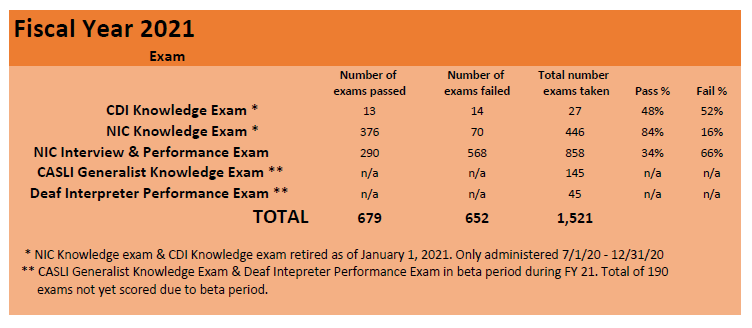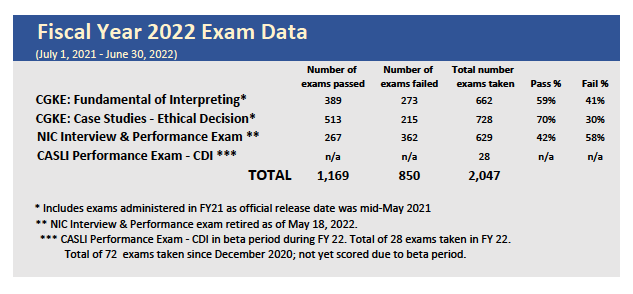Exam Statistics
Pass/Fail Rates
Understanding Pass/Fail Rates:
During exam development and ongoing maintenance, an exam scoring committee is convened to determine the cut score of an exam. The cut score is the score at which the minimum level of knowledge or competency is determined.
For illustrative purposes, let’s suppose that an exam has 100 opportunities to assess whether a candidate demonstrates competency to apply knowledge, demonstrate skill, or complete tasks as an ASL-English interpreter in a general setting (for instance, suppose there are 100 questions on a test, or there are 100 minutes in a performance exam). The scoring committee, with guidance from a psychometrician, will analyze each assessment opportunity for importance, or weight, and then determine the minimum level at which demonstrated competency within each domain on the exam (broader area within the job task analysis, e.g. pre-commitment, pre-encounter, encounter, etc.) is acceptable. From there, a cut score – the score at which a candidate meets or exceeds the acceptable minimum level of demonstrated competency for interpreting in general settings – is determined. To continue the above-mentioned example, a scoring committee may determine that a candidate needs to accurately respond to 85 (or more) out of 100 points of assessment on an exam, and then also accurately respond to at least 75% of the points of assessment within each of five established domains on the exam to pass the entire exam.
The pass/fail rate is the rate at which the entire pool of candidates who took a specific exam meets or exceeds OR fails to meet the acceptable minimum level of demonstrated competency for interpreting in general settings (or cut score).
The pass/fail rate indicates the competency levels of the entire pool of candidates who took that exam during a specific time frame (CASLI uses the July 1st to June 30th time frame). As CASLI exams are national exams, the pool of candidates span the entire country.
Pass/fail rates do not, in any way, indicate an individual candidate’s likelihood of passing or failing a specific exam. Consider these opposite scenarios:
A candidate works on broadening and deepening their knowledge of the ASL-English interpreting profession, gains skills in applying that knowledge, works on improving their ASL and English skills to achieve advanced or better fluency in both languages, gains the ability to accurately relay interpretation between the two languages while achieving a dynamic equivalence across a continuum of ASL and sign languages, learns to make decisions during interpreting based on sound and professional ethics while being culturally aware and sensitive to consumers involved. That candidate may have a higher likelihood of passing their exam.
A candidate acquires fluency in ASL and may socialize with other ASL users, but does not engage in any activities that will teach, improve, or refine their interpreting skills. That candidate may have a lower likelihood of passing their exam.
The pass/fail rates presented below are that of all test-takers during that fiscal year and the percentages are indicative of the readiness of the entire pool of candidates for certification, rather than any specific group of (e.g. heritage ASL-users vs. ASL-as-a-second-language users), or any individual candidate (e.g. many erroneously believe that if the passing rate for an exam is 50%, an individual candidate will have a 50/50 chance of passing.)
CDI-Knowledge Exam: The passing rates have hovered around 50%. The exam itself is a paper and pencil exam offered in written English, ASL (via video) and/or both.
NIC-Knowledge Exam: Generally, the passing rate for this exam has been in the upper-80s to 90% and have been consistent for many years. The NIC-Knowledge exam is a computer-based-test, administered in written English only and may indicate that a majority of NIC-Knowledge candidates are well prepared for the NIC Knowledge Exam.
NIC-Interview & Performance Exam: The passing rate for the NIC-Interview and Performance Exam has hovered between 25% to 30% since its launch on December 1, 2011. Data analysis on the various skills that are evaluated on this exam indicate an area where candidates struggle overall is interpreting from ASL into English. Candidates consistently scored lower on this component than interpreting from voiced English into ASL.
Time Frame for Pass/Fail Rates:
CASLI’s Fiscal Year runs from July 1 to June 30th of each year and the annual pass/fail rates are calculated from exams administered between those dates. CASLI was formed on July 1, 2016, at the start of the 2017 Fiscal Year.
CASLI’s Pass/Fail Rates for Fiscal Year 2017-2020
CASLI’s Pass/Fail Rates for the 2017 Fiscal Year:
CASLI’s Pass/Fail Rates Published in RID’s 2017 Annual Report
CASLI’s Pass/Fail Rates for the 2018 Fiscal Year:
CASLI’s Pass/Fail Rates Published in RID’s 2018 Annual Report
CASLI’s Pass/Fail Rates for the 2019 Fiscal Year:
CASLI’s Pass/Fail Rates Published in RID’s 2019 Annual Report

CASLI’s Pass/Fail Rates for the 2020 Fiscal Year:

CASLI’s Pass/Fail Rates for the 2021 Fiscal Year:

CASLI’s Pass/Fail Rates for the 2022 Fiscal Year:

CASLI Demographic Reports for Exams
CASLI’s Fiscal Year runs from July 1 to June 30th of each year and the demographic report focus on candidates who took their exams in that particular FY. Click below to access to FY Demographic reports.
